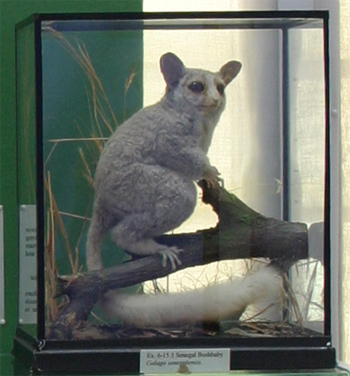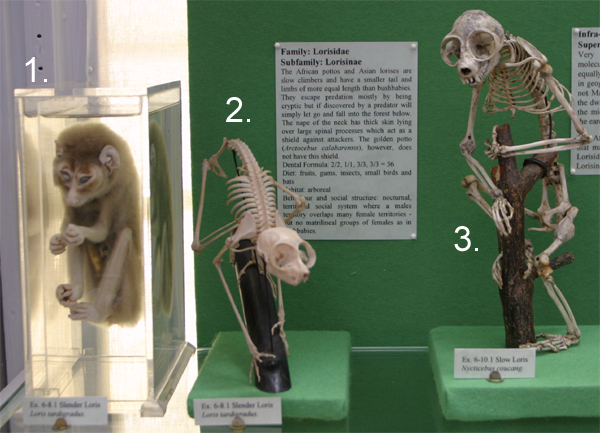
SUBORDER STREPSIRHINI
INFRAORDER LORISIFORMES
SUPERFAMILY LORISOIDEA
AFRICAN GALAGOS AND ASIAN LORISES
One of the main differences between the galagos and lorises and the lemurs is their geographical distribution. Galagos and lorises live in mainland Africa and Asia. Lemurs are confined to Madagascar. Other differences are unapparent and morphological for example the structure of the carotid artery.
Galagos and lorises are interesting in that the two groups have developed very different approaches to a nocturnal, arboreal way of life. They live in very different habitats and move in very different ways. Their different diets, ways of obtaining food and evading predators are determined by the different ways they move. Being nocturnal they do not compete with monkeys as monkeys are diurnal.
FAMILY GALAGIDAEAfrican galagos or bush babies are particularly adapted for rapid movement: they are active vertical leapers. Their hind legs are long and well developed and their tails are long. Using their legs to spring, they can cover 10 metres in less than 5 seconds. Their speed enables them to catch fast-moving prey and to evade predators. They have large ears and eyes with good night vision which help their nocturnal way of life. They communicate by scent and loud cries. Galagos live in thick foliage of the rain forest and in trees in the savannah. Most species eat gum as well as fruit, insects, nectar, small birds and lizards. Related females share territories with a dominant male ranging over many such territories. Galago senegalensis, the Senegal Bush baby, lives in dry acacia woodlands and thickets in West Africa. Galagos not only use the toothcomb to groom their fur but also to gouge drops of gum out of tree branches. Under their tongues they have an accessory tongue-like structure which is used to clean the tooth comb. Although gum is a low energy food, they still manage to move at lightening speed if alarmed. As well as gum, Senegal galagos eat fruit and insects. They locate insects by sound and can catch them on the ground or vegetation or even on the wing by rapidly grasping the prey between the palm and tip of the little finger. |
 |
FAMILY LORISIDAE
Lorises – the name is Dutch for clown –are renowned for moving very slowly and smoothly. They are highly specialised morphologically to climb in trees or cling to branches having fore and hind limbs of equal length and very short tails. They practice ‘cryptic locomotion’ by moving extremely slowly through thick vegetation which hides them from predators. If alarmed, they may freeze remaining immobile for hours and even days or just fall into the forest below. These animals have to live in thick vegetation which can conceal them from view if this approach to avoiding predators is to succeed. Lorises have a territorial social system whereby a male’s territory may overlap the territories of many females. Unlike female galagos, female lorises do not form groups of related females. Lorises feed on fruits and gum and slow-moving prey which they find by smell. Although the insects they feed on are easy to find by smell, many are irritant and unpalatable and lorises must be adapted to survive the ingestion of the irritants and toxins these insects produce.

1 and 2. Adult and skeleton of Loris tardigradus. The slow loris lives in the tropical forests of West India and Sri Lanka. The adult show the typical appearance of a loris: large eyes, short snout, legs of equal length and no tail. The skeleton shows how the animals climb.
3. Skeleton of Nycticebus coucang. The slender loris lives in Vietnam and Borneo. This species has a very mobile hip joint for climbing; its opposable first digit on hand and foot are used to grip branches strongly. It has no tail. This specimen must have suffered a broken thigh at one time: the limb has healed but the bone where the limb broke is very thick.






